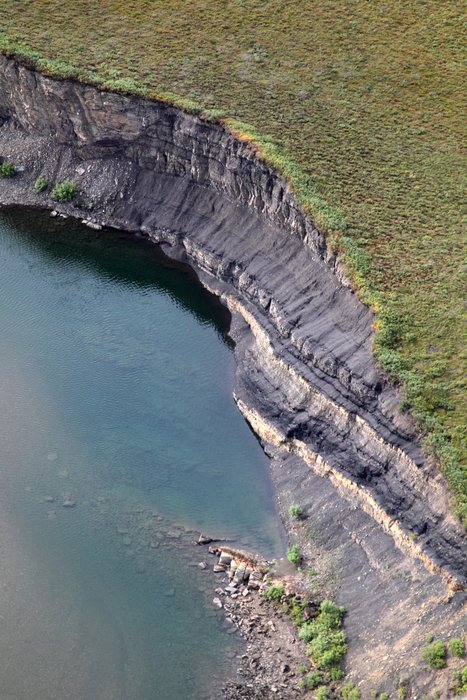
Most of Alaska’s coal can be found in the northern part of the state, north of the Brooks range, near the Chukchi and Beaufort Seas. 88% of the state’s identified coal resources are in these Arctic deposits. Although this coal has a higher energy content than coal at Usibelli Coal Mine (Alaska’s only active mine), and Chuitna (an active prospect), the deposits are very remote and have never been mined on a large scale.
Recent exploration has been conducted at the Deadfall Syncline on the western edge of this area. And as of early 2011, the state is seeking to grant preliminary permits for coal prospecting in the Nanushuk deposits on the eastern edge of the range. Any coal development in the arctic will have to overcome difficulties of the lack of infrastructure, transportation, and the unique challenges of reclaiming a coal mine in permafrost.
History
Coal was first mined in the area in 1879 at Corwin Bluff east of Cape Lisburne. In the late 1800s a scattering of small-scale mines provided coal for ships and local communities. In 1941 a series of U.S. Department of Defense orders opened northern Alaska to coal development, leading to the opening of mines at Kuk River, Atkasuk (Meade River), Peard Bay and several other sites - all of which were closed by the 1950s. Exploration began again during the 1980’s and in 1990 a few hundred tons of coal from the area were burned in a number of test furnaces nearby.
Nanushuk Coal Prospect
In 2010, the state of Alaska issued a preliminary decision on the Nanushuk Coal prospecting permits The area in question is just north of the Brooks Range and just west of the haul road - extending from 5 miles west of Toolik Lake to 3 miles west of the Anaktuvuk River. For more information, see our detailed article here.
BHP Billiton Exploration
The world’s largest mining company has had off-and-on interest in developing coal in Alaska’s western arctic. In 2006, BHP Billiton began what was intended to be a 5-year coal exploration program on Arctic Slope Regional Corporation land, at the Deadfall Syncline about 40 miles south of Point Lay on a lease that covers 1.75 million acres. In January 2009, BHP Billiton suspended the drilling program and reviewed the project. In September 2009, BHP determined that the project was not economically viable, and terminated their exploration.
“This review has determined that while the Western Arctic Coal Project holds large coal resource potential, BHPB’s internal economic hurdles required for long-term development were not being met within today’s financial environment. BHPB has terminated its agreement with ASRC and has therefore concluded its exploration activities and project activities will now focus on reclamation and rehabilitation of the project site.”
However, in August 2010 BHPB filed an application with the DNR to renew their coal leases in the area and maintain the airstrip and other facilities used for exploration.
Arctic coal deposits

The western arctic has a lot of coal - certainly most of the coal in Alaska, and likely a large portion of the coal in the US. Just how much is a matter of debate. Some of the uncertainty stems from the fact that relatively little exploration has been done in the area. But most of the difference comes down to how you quantify it. The most dramatic numbers approach 4 trillion tons, but include " hypothetical resources " - resources that are present in known but incompletely explored or unmapped coal beds, more than 3 miles from a measurement point.
Compared to coal in the lower 48, there are significant challenges to developing Western Arctic coal. There are no, roads, railroads, or mines in the area, and the nearby Chukchi sea is ice-covered much of the time. BHP Billiton’s project idea would have called for a new railroad to bring coal a couple hundred miles to the nearest port (currently used for zinc from the Red Dog Mine).
Permafrost (underlying the entire area) is an environment where reclamation of coal mines is expected to be very difficult. Additionally, the impact of burning this coal has the potential to impact this arctic area disproportionately, through the effects of climate change.
.png)
The majority of this coal lies in the National Petroleum Reserve, with significant areas owned by Arctic Slope Regional Corporation (a native corporation), and a smattering of other federal, state, and privately-owned pieces.
In the north of this area, the coal underlying the Arctic coastal plain is a low-sulfur subbituminous coal with a heat value of 9,800 BTU/lb. Further south towards the Brooks Range the coal becomes bituminous with a heat value of ll,000 BTU/lb and an average sulfur content of 0.6 percent. Much of this coal is in rocks of Cretaceous age, but there is also some low-volatile bituminous coal (about l4,000 BTU/lb) in highly deformed rocks of Mississippian age near Point Hope. The coal at the Deadfall Syncline (BHP Billiton’s exploration area) has an average energy content of 12,900 BTU/lb.
Created: Jan. 19, 2018